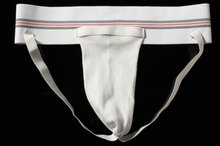What Is the Difference Between Men's & Women's Hockey Equipment?
After the 1998 Winter Olympics, at which women's ice hockey premiered as an Olympic sport, the popularity of women's hockey saw a sharp increase 1. As a result, some hockey equipment manufacturers started to market female-specific equipment 1. This equipment differed from the standard men's gear in proportions, weight and anatomical fit. Other companies, while not producing female-specific lines, have broadened the scope of their offerings to teenage male players. The sizes and proportions of this equipment, smaller in scale to men's equipment, are also suitable for female hockey players 1.
If you are experiencing serious medical symptoms, seek emergency treatment immediately.
Equipment Made For Women
A hockey player is covered in equipment from head to toe 1. When looking at men and women you can see obvious physical differences. Some hockey equipment suppliers offer gear to address these variations 1.
A major difference in male and female body types is the shape of the hips. Women, generally, have wider hips and shorter torsos. As a result, female-specific hockey pants tend to have more room in the hips and shorter hip guards -- the top of the pant -- than a standard man's hockey pants.
Another obvious difference in male and female anatomy is the chest area, which can affect the fit of shoulder pads. Women's shoulder pads are equipped with molded cups to accommodate larger chests, whereas men's shoulder pads are fitted with a flat front.
The most popular piece of female specific equipment is the pelvic protector. It is the most commonly used because the men's version, the protective cup, is the only piece of hockey equipment that cannot be comfortably worn by women 1.
One piece of equipment, the skate, has seen a few attempts at a female-specific line. This is not a popular offering. Hockey skates made for women are lighter and have a shorter boot to accommodate a woman's smaller calf 12. However, relatively few female hockey players see a women's specific skate as a better option than a junior skate, which is also lighter than a man's skate 1.
- A hockey player is covered in equipment from head to toe 1.
- Another obvious difference in male and female anatomy is the chest area, which can affect the fit of shoulder pads.
Junior Unisex Equipment Used By Women
Male Vs. Female Skeleton
Learn More
Alternatives to female-specific equipment used by women hockey players are pieces made for teenagers 1. This equipment is smaller in size and proportion. Although not made specifically for the female athlete, this gear can work well to meet the needs of a woman player. Junior-size sticks, gloves and skates are among the common crossovers to women hockey players 2. An added bonus to the sizing appeal of junior equipment is that it is often less expensive than adult gear.
Junior-size sticks are more flexible than an adult stick, which provides the necessary whip to strengthen a shot. Additionally, junior sticks tend to have a smaller shaft than adult sticks, which can better accommodate a woman's smaller hand. Smaller gloves, in the 12- to 13-inch range, that are marketed for junior-age players, also work well for women. These sizes have shorter fingers, a smaller palm and a shorter cuff.
Hockey skates are another example in which many female players use junior sizes. If a woman wears a 5.5 size skate or smaller, she will fit into a junior skate.
Most other equipment, including shin pads, goalie gear and helmets, provide junior sizing that will fit female players.
- Alternatives to female-specific equipment used by women hockey players are pieces made for teenagers 1.
- Additionally, junior sticks tend to have a smaller shaft than adult sticks, which can better accommodate a woman's smaller hand.
Drawbacks to Women's and Junior Equipment Used By Women
One of the major drawbacks to female-specific hockey equipment is variety in brands 1. Only a small handful of manufacturers offer women's gear, limiting choice and providing little competition to improve quality. Junior equipment, while meeting the sizing needs of women hockey players, is made for teenagers and children 12. This often means that the durability and overall quality is lower than adult gear made for men. Younger players tend to play two to three times per week and will not put as much strain on equipment as a female college player who is on the ice six days per week. Under such strains, junior equipment can wear out and break down faster than the adult versions.
- One of the major drawbacks to female-specific hockey equipment is variety in brands 1.
- This often means that the durability and overall quality is lower than adult gear made for men.
Look for Fit, Protection and Comfort
The Proper Way to Wear an Athletic Supporter
Learn More
Whether a player chooses women's, junior or men's equipment, the primary objectives are to find gear that fits properly, protects well and feels comfortable 1. To ensure that these important criteria are met, an ice hockey player, male or female, should enlist the help of an equipment expert when suiting up 1.
Related Articles
References
Writer Bio
Jodi McKenna-Cunningham has worked as a hockey and strength and conditioning coach for over 14 years. She is currently the head coach for Wesleyan University and the U.S. U-18 National Team, which won gold at the 2011 World Championships. McKenna-Cunningham was an assistant coach for the U.S. 2010 Women's Olympic Team. She also played varsity hockey at Brown.









